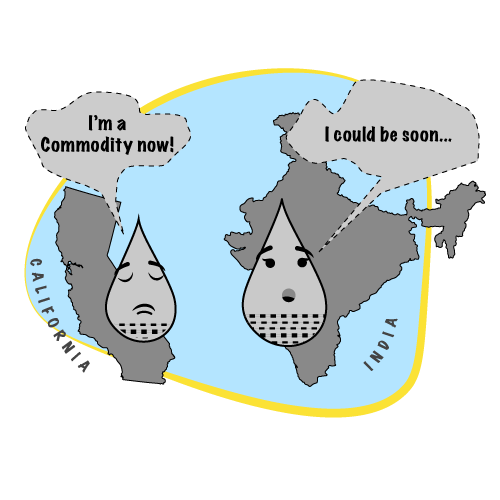Californian Water Market : Is India Ready to Trade Water as a Commodity like California?

In an unprecedented move, water has joined the panel of commodities and is now ready to be traded on the US Derivatives market. Water is, therefore, the newest addition to the traded commodities and is launched on the Chicago Mercantile Exchange and the contract has been linked to California’s $1.1 billion spot water market. Basically, the CME group based in Chicago which is the world’s leading and most diverse derivatives marketplace offering the widest range of futures and options products for risk management1 has initiated and decided to trade water as a future commodity.
Although the measure has been introduced in order to bring efficiency in California’s water sector amid fear of scarcity, however, a cascade of vitriolic questions have been itemized by activists fearing that such an unprecedented move may vilify the pillars of human rights. The human right activists are of view that such a measure implemented for now in California may be idolized by other nations and that a ripple effect shall create a devastating effect in economies especially the Agrarian ones. Currently, India is also under a threat of water paucity, and therefore, India may deem to be a fit country for being experimented with the Californian water model, however, several hurdles may obstruct the discourse taking legislative action in the territory of India.
Firstly, Agriculture contributes 18% of the GDP in India and provides employment to approximately 50 percent of the Indian workforce. On the other hand, 80% of the groundwater is alone used for the purposes of agriculture in India.2 Factually, 15,000 litres of water is used on average to produce one kilogram of paddy taking into account that 45% of water is solely used for rice cultivation.3 Therefore, there is a contradiction between the right to employment and the right to food on one side and the right to water on the other side, making it unmanageable to ensure equilibrium between such rights. Hence, if the idea of commodifying water is eulogized in India, severe distress is expected in the field of agriculture resulting in massive unemployment of youth as well as adults, and also a situation of famine can be warranted.
Moreover, the Roman doctrine of public trust has been sincerely followed in India and different High Courts and Supreme Court has majorly contributed in evolving its jurisprudence. Dialectically, the public trust doctrine means that certain natural and cultural resources are preserved for public use and that the government owns such resources and they are bound to protect and maintain their resources for the common use of the public. In the United States, this doctrine is applicable most frequently to protect bodies of water as most lakes and streams in the US are maintained under the ambit of this doctrine so as to make this resource available for the purposes of drinking and recreational activities.4
Talking about India, the division bench of the Supreme Court in the case of MC Mehta v. Kamal Nath5 has held that “Our legal system – based on English Common Law – includes the public trust doctrine as part of its jurisprudence. The State is the trustee of all natural resources which are by nature meant for public use and enjoyment. Public at large is the beneficiary of the sea- shore, running waters, airs, forests and ecologically fragile lands. The State as a trustee is under a legal duty to protect the natural resources. These resources meant for public use cannot be converted into private ownership.” The essence of the quoted lines above makes it crystal clear that the privatization of natural resources is against the law of land as it causes obstruction in public use and enjoyment and it also calls for questioning the state regarding its legal duty to protect the natural resources. Hence, natural resources like water cannot be converted into a product of private ownership and commercial use as per the Indian environmental jurisprudence.
The Constitutional safeguards under Article 14, 19, 21, 48, and 51(1)(g) of the Indian Constitution also acts as a fortified layer in regard to the protection of natural resources from being economically and monetary bartered. Thereby, if the water is planned to be commodified in India, there is a potent risk of fundamental rights of equality and right to life being infringed through the application of this measure. Henceforth, India although facing acute problem of water shortage and scarcity where 50% of the Indian population does not have drinking water, and if seen through a myopic view, is in extreme fear to face a severe crisis, still, the idea of water commodification does not convince the sovereign of the country and is profoundly against the principles of Constitutionally runned territory. At the same time, there is also a fear that when the water sector in India is not-so-highly regulated, privatization will lead to corporates entering and dominating the sector and there is a high possibility that the cartels may be created which in result could cause hindrance to the access of water to the majority of people.
Nonetheless, water scarcity is really a problem that has now touched the shore and if not been alarmed, there can be a massively detrimental effect. The solution has to be searched for where water could play the Janus: both as a vital resource and an economic asset so that fair distribution of water is not affected and that the citizens could be more conscious while using water as a pristine resource. Even if we move forward with the idea of declaring water as an economic good in India, the biggest problem that would knock the door is the problem of concentration of resources in the hands of few. If the regulations regarding water trading are strict and in compliance with the Constitution of India, the economic method of battling the water crisis could turn out to be a feasible and adaptable method.
Applications of water-oriented market allocation mechanisms can be studied and understood by seeing the complexities arrived in different nations like China and Australia when they implemented the same. In 2016, the Ministry of Water Resources in China has released Provisional Measures on Administration of Water Rights Trading6 in order to understand the water trading practices. Such provisions can be examined and may be modified as per the needs and demands of the Indian Territory. Therefore, the idea of commodifying water is naïve and difficult to be accustomed to as per the territory of India, however, the same can turn out to be a global situation, if implemented with caution, to fight the problem of the water crisis.
References

